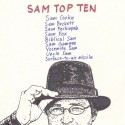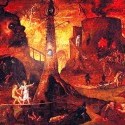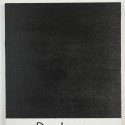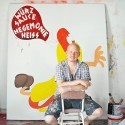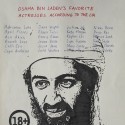QUID PRO QUO
14 July 2015, Cervera de los MontesI like bartering my works to things. I guess it's illegal black economy. I made a portrait of Sam and this text is what I got in exchange.
RIIKO SAKKINEN AND POSTMODERN "POP ZEITGEIST" – IRONY AND PROVOCATION IN THE TURBOCHARGED AGE?
Der Zeit ihre Kunst. Der Kunst ihre Freiheit.
"To every age its art. To every art its freedom." These famous words by Hungarian-Austrian writer and journalist Ludwig Hevesi (1843–1910) can be found as a key motto of The Vienna Secession building (Das Ausstellungshaus der Wiener Secession)1. Hevesi's stimulating words have been used and referred to, especially in Europe, already for many generations.
Hevesi himself remains a kind of mystery. Even the name is a pseydonym – in connection with Havesi we find names such as Ludwig Hirsch, Lajos Lövy and Lőwy Hevesi Lajos in history books and documents.
Hevesi's seminal words easily come into mind when discussing Riiko Sakkinen's art (and life) project. Writing these sentences in summer 2015, I ask myself – maybe even stronger and more demandingly than ever before – what on earth is or could be the Art of the late modern and postmodern age.
An even more difficult and relevant question follows: what can be the "freedom" of Art in the postmodern cultural condition and the global, supertechnological, money-driven, profit hungry and hyperconnected age? In the age that is fulfilled with and bombarded by slogans, media spectacles, entertainment, infotainment, Hollywood dreams, computer effects, s(t)imulation, broadcast banalities, televised hyperrealities and sarcastic Internet messages (including so-called "social media" which is, in fact, often "anti-social")?
Postmodern cultural theory has aptly used key expressions such as the ecstasy of communication and the implosion of meaning (Baudrillard) to characterise the contemporary world. These expressions are true and relevant both as regards mass media, digital networks and various electronic agoras (Facebook, Twitter etc.). Today communication is everywhere (and nowhere). Today media is both very relevant and trivially irrelevant. We meet the challenges of understanding and misunderstanding. You exist only if you exist in the media, they say. And they're wrong.
Superficial, bombastic political rhetoric goes hand in hand with superficial and often naive business and product rhetorics. An observation: there is too little deep, open, critical and melioristic discussion in the society (regardless of the ideological or political position). Instead, hyperbolic promotion, presentations and propaganda can be found everywhere. Not enough real dialogue – but lots of monologues with turbocharged attitude. This is often the status quo of the so-called information and media society. An observation and a wish: we need less naive and minuscule small talk or hype and much more harmonic silence. We also need more significant thinking, deep reflection and Big Talk in our media saturated and simulation hungry society.
Art and the System? Art hacking the System? It seems Riiko Sakkinen has taken irony, provocation and interventions as his strategic and tactical ways to comment on the contemporary world, the late modern and/or postmodern culture and "the society of the spectacle" (Debord).
In Erlebnisgesellschaft (experience society, cf. Schulze) acts, effects, spectacles and experiences compete with other acts, effects, spectacles and experiences. Audiences might agree or disagree with the sender. The messages might be provocative and ambivalent. Sakkinen's artistic works and activities bring into mind the historic legacy of dadaists, situationists, punkers, pranksters and hackers of past decades.
* *
The need to define an era and its "spirit" has been a characteristic of (post)modern culture. Originating in the 18th and 19th century German romanticism, the concept of Zeitgeist has been considered important and feasible in academic circles, arts, curator texts, bourgeois salons and journalism alike.
As a generalisation, the spirit of the age has been used to attempt to define a general meaning and mentality, i.e. the key values, goals and central themes present in a certain moment in a given sociocultural framework. To cite The Fontana Dictionary of Modern Thought (1988):
Zeitgeist. German word meaning literally "the Spirit of the Time (or Age)". It is associated with attempts to epitomize the mode of thought or feeling deemed fundamentally characteristic of a particular period, e.g. to interpret the 19th century as an age of "heroic materialism" (Kenneth Clark). The term was first regularly employed by the German Romantics [...]. Tempted always to reduce the past to essences, they often treated the Zeitgeist less as a conceptual instrument than as a grandiose historical character in its own right. Most historians handle the term with caution on the grounds that the characteristics of any historical period are more complex than a formulation of Zeitgeist can suggest.2
It feels natural to link the term 'Zeitgeist' to the theologian and poet Johann Gottfried Herder (1744–1803) and especially to the intellectual heritage of G. W. F. Hegel (1770–1831); to the interpretation of culture – or Geist? – as a continuous dialectic (thesis, antithesis, synthesis).
We can try to track down the Zeitgeist of any historic period. The thematic similarities between different epochs are interesting. Age of Enlightenment and the Modernity, Romanticism and Postmodernism, "internationalism" of the last centuries and today's "global village" (McLuhan)… The spirit of an age is visible, for example, in literature, architecture, fine arts and pop music. Historians tend to take a skeptical view of the concept, however, because mapping the spirit of any age often requires black and white generalisations.
Quo vadis, Western culture? Quo vadis, Mother Europe? Quo vadis, Facebook Generation? In addition to global processes, cultural megatrends and new (ubiquitous) technologies, the "Pop Zeitgeist" (i.e. pop music, pop culture, pop art….) seems to dominate today's society. The 20th century was an epoch of audiovisual media and pop culture (cinema, television, music video, electronic art, techno parties, multimedia…). The 21st century might be an epoch of new "Electro Pop" (cf. Kraftwerk): advanced sensory interfaces and man/machine systems, virtual realities, futuristic artificial intelligence, "spiritual machines" (cf. Kurzweil) and transhumanism.
What is the Zeitgeist of today? A spontaneous list of central themes could begin like this: climate change and global risks, wicked problems, rise of China and Asia, economic turbulence and cultural "turbolence," new technologies, cyber attacks and terrorism, escalating fundamentalism, super consumerism, experience economy, simulation and stimulation, hypersexualisation, pornographisation, biosciences, drones and cyborgs, gene manipulation, medicalisation, escapism, troubled psyches…
On the other hand, spiritual ideas and concepts (retreats, monasteries, meditation, yoga, new age, etc.) and issues such as slow life have been on the rise in value maps – all acting as a sort of a counter balance or opposing trend to the hectic, accelerated, machinic, fearful, cynical and nihilistic contemporary society – the society that sometimes seems to suck the blood out of its constituents.
In 2015 A.D., what is (or could be) the cultural mission of an artist? In an era of media and communication, hyperrealism, nomadism, multiculturalism and postmodern identity games (cf. Bauman), how can an artist best mirror and interpret the spirit of the age? And should we prefer a plural form here: are there (more accurately) many "spirits" in the postmodern "Pop Zeitgeist"? How do they relate to social tensions, cultural differences and the so-called clashes of civilizations (Huntington)?
At least art(ist) can comment on the developments, trends and so-called weak signals of its age. The artistic methods might include demystification, provocation, irony, dramatic moves, peculiar acts and – in the spirit of the Situationist International (SI) – detournement (= rerouting, hijacking). This all can happen in the real physical world (e.g. oil on canvas), on broadcast media or online in "cyberspace."
It feels natural to say that Riiko Sakkinen (b. 1976) is a "Zeitgeist artist" who creates "Zeitgeist art" in the new millennium – and whose provocative themes and works both reflect and comment on the changes of contemporary culture and society.
* *
O tempora, o mores!
Surrounded by financial crises, turbulences, climate change, pension bombs, avian flu, swine flu, ebola outbreaks as well as old and new forms of violence, the Western soul is troubled by confusion, fear and contradicting moods. New forms of activism, radicalism, anarchism, camp and kitsch are emerging.
Culturally pessimistic prognoses portray meltdowns, fights, evolutions, revolutions, devolutions and the Untergang (downfall) of the Western civilization (cf. Spengler). The optimists, on the other hand, smilingly await the future and believe in the new oppurtunities and utopian energies of the coming years. Digitalization has become the new "lingua franca" of the globalised, technologised age. According to critical minds, numbers, measures and excel spreadsheets are the spiritual barometers of our technocratic and computational age. According to technophilic and cyber optimistic people, on the other hand, fantastic (r)evolutions and better life are right ahead of us.
Times are – again – changing. And to refer to Heraclitus of Ephesus (c. 535 – c. 475 BCE), everything changes, everything flows. All in all, we live in a hectic, turbulent, surprising and perplexing age. It goes without saying that Zeitgeist discourses also revolve around power. The spirit of the age is often primarily defined by people who consider themselves opinion leaders (of their generations) who operate in the centre of cultural dynamics. Where contemporary diagnoses are concerned, the words of the philosopher, cultural critic and essayist Walter Benjamin (1892–1940) hit the mark: soothsayers do not experience their time as homogenous or empty.3
And what about Das Kunstwerk im Zeitalter seiner technischen Reproduzierbarkeit ("the work of art in the age of mechanical reproduction"; W. Benjamin)? What on earth can Art be in the age of fast and ecstatic "Xerox culture," quick and dirty mentalities and postmodern "Pop Zeitgeist"? How can works of art communicate in the age of cybernetic systems, digital technologies, robotics, artificial intelligence, transhumanist visions, turbocharged psyches and flexible identities?
And some more significant questions: what are the benefits of art? Can art really change the world (as we were told in school)? For years writers, copywriters, fine artists, make-up artists, pop stars and sport stars have commented on the world around them. And how about the quality of life, culture and society? How about "the revolution of everyday life?" Traité de savoir-vivre à l'usage des jeunes générations (Vaneigem)?
Philosophical and aesthetic analyses are not enough. Art is also a social and ideological phenomenon. We can see postmodern art created in a postmodern way in the postmodern world. Riiko Sakkinen has used the term "turbo realism" to describe his art works. Sakkinen's ironic, provocative activities and playful interventions seem to test the relevance and meaning of Hevesi's classic words.
"To every age its art. To every art its freedom."
Dr. Sam Inkinen
Media Scholar, Writer, Curator
(July 2015)
With special thanks to Leo Westerlund.
Notes
1. Wiener Secession; also known as the Union of Austrian Artists, or Vereinigung Bildender Künstler Österreichs.
2. The Fontana Dictionary of Modern Thought. Edited by Alan Bullock & Oliver Stallybrass. London: Fontana Press, 1988 [1977], p. 916.
3. See Walter Benjamin, On the Concept of History [Über den Begriff der Geschichte], 1940.
